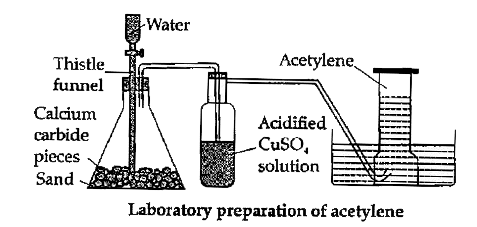Give reason why?
The blue colour of the Copper sulphate solution persists even during its electrolysis using copper electrodes.
Step-by-Step Solution:
1. Understanding Electrolysis: In electrolysis, an electric current is passed through a solution (electrolyte), causing chemical reactions at the electrodes. In this case, we are using copper electrodes in a copper sulfate solution.
2. Identifying the Electrodes: The negative electrode (cathode) is made of pure copper, while the positive electrode (anode) is made of impure copper.
3. Dissociation of Copper Sulfate: When copper sulfate (CuSO4) is dissolved in water, it dissociates into copper ions (Cu²⁺) and sulfate ions (SO₄²⁻). The blue color of the solution is due to the presence of Cu²⁺ ions.
4. Role of Sulfuric Acid: Dilute sulfuric acid (H₂SO₄) is added to the solution to enhance conductivity. It dissociates into hydrogen ions (H⁺) and sulfate ions (SO₄²⁻).
5. Reactions at the Electrodes:
- At the Cathode: Cu²⁺ ions gain electrons and are reduced to form solid copper (Cu). This can be represented as:
Cu2++2e−→Cu (s)
- At the Anode: Copper from the anode is oxidized to Cu²⁺ ions, releasing electrons. This can be represented as:
Cu (s)→Cu2++2e−
6. Conservation of Copper Ions: For every Cu²⁺ ion that is reduced at the cathode, an equivalent amount of copper is oxidized at the anode. Therefore, the total number of Cu²⁺ ions in the solution remains constant.
7. Conclusion on Color Persistence: Since the concentration of Cu²⁺ ions does not change during the electrolysis process, the blue color of the copper sulfate solution persists throughout the electrolysis.
Final Answer:
The blue color of the copper sulfate solution persists during electrolysis using copper electrodes because the concentration of Cu²⁺ ions remains unchanged. For every Cu²⁺ ion that is deposited at the cathode, an equivalent amount of copper is oxidized to Cu²⁺ ions at the anode, maintaining the blue color.
- At the Cathode: Cu²⁺ ions gain electrons and are reduced to form solid copper (Cu). This can be represented as:
Cu2++2e−→Cu (s)
- At the Anode: Copper from the anode is oxidized to Cu²⁺ ions, releasing electrons. This can be represented as:
Cu (s)→Cu2++2e−
The blue color of the copper sulfate solution persists during electrolysis using copper electrodes because the concentration of Cu²⁺ ions remains unchanged. For every Cu²⁺ ion that is deposited at the cathode, an equivalent amount of copper is oxidized to Cu²⁺ ions at the anode, maintaining the blue color.
Topper's Solved these Questions
Similar Questions
Copper sulphate solution does not react with
View SolutionGive reason :
The blue colour of aqueous copper sulphate fades when it is electrolysed using platinum electrodes.
View SolutionGive reasons for the following
The blue colour of aqueous copper sulphate fades when it is electrodes.
View SolutionState one relevant observation for each of the following: At the Anode when aqueous copper sulphate solution is electrolysed using copper electrodes.
View Solution
Give the function of acidified copper sulphate solution.
View SolutionWhy does the colour of copper sulphate solution change when an iron nail is dipped in it?
View SolutionCopper can be reduced from acidic copper sulphate solution by
View SolutionWhich metal can deposit copper from copper sulphate solution ?
View SolutionWrite the reactions at the cathode and at the anode during electrolysis of copper sulphate using copper electrode.
View SolutionWhat is seen to happen to the colour of the copper sulphate solution if platinum electrodes are used ? Explain this observation .
View Solution
